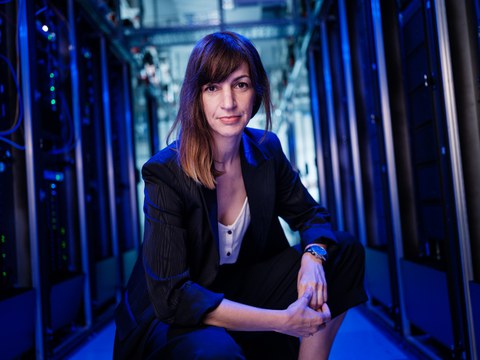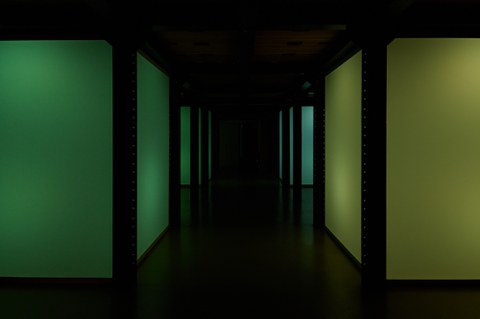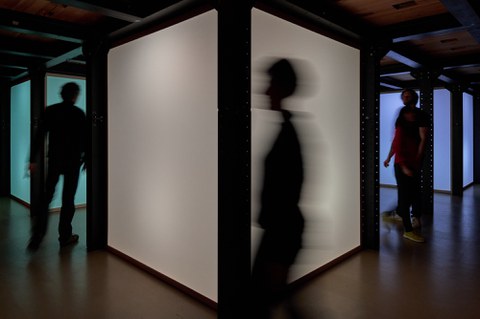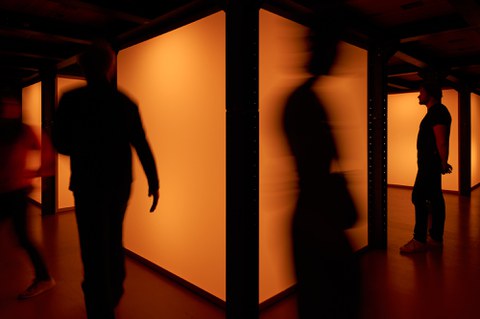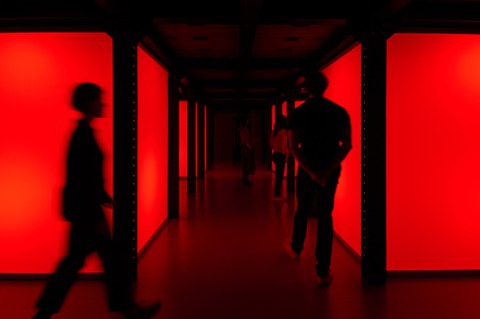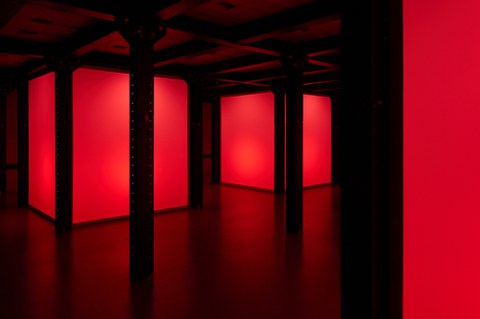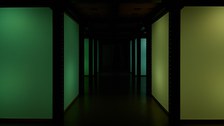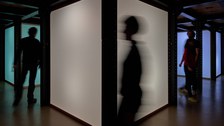Artist in residence 2022: Esmeralda Conde Ruiz
Von April bis Ende September 2022 war die Komponistin, Dirigentin und Künstlerin Esmeralda Conde Ruiz (*1980/Spanien, lebt in London) für sechs Monate im Lab zu Gast. Hier arbeitete sie – gemeinsam mit den Stipendiat:innen des Schaufler Kolleg@TU Dresden, Wissenschaftler:innen der TU Dresden sowie weiteren Partner:innen, wie etwa der Hochschule für Bildende Künste Dresden und HELLERAU – Europäisches Zentrum der Künste – gemeinsam an einem künstlerischen Forschungsprojekt zum Thema „Künstliche Intelligenz als Faktor und Folge gesellschaftlichen und kulturellen Wandels“.
Während ihres Aufenthalts im Lab entwickelte sie ihre Forschungen auf dem Gebiet der Künstlichen Intelligenz und des mehrstimmigen Gesangs mit Hilfe von Prof.in Miriam Akkermann, Juniorprofessorin für Empirische Musikwissenschaft am Fachbereich Musikwissenschaft des TUD-Instituts für Kunst- und Musikwissenschaft, weiter.
Esmeralda Conde Ruiz´ Projekt beleuchtet unter anderem folgende Fragestellungen: Können wir KI als Instrument statt als Werkzeug in der kompositorischen Praxis einsetzen? Wie kann ein Mensch auf die KI einwirken, wenn sie in diesem Kontext als Instrument eingesetzt wird? Kann KI eine eigene Stimme und damit einen individuellen Klang finden bzw. entwickeln?
Unterstützung bei der akustischen Entwicklung leisteten Prof. Dr.-Ing. Ercan Altinsoy, und Dr. Sebastian Merchel, Lehrstuhl für Akustik und Haptik am Institut für Akustik und Sprachtechnologie an der TUD-Fakultät für Elektrotechnik und Informationstechnik. Das Institut verfügt über drei spezielle Akustikräume, in denen Conde Ruiz spezifische Klänge, insbesondere Maschinengeräusche, untersucht. Das Material für die akustischen Kompositionsstudien stammt aus ihren eigenen Aufnahmen, die sie vor Ort an der TUD macht. Eine zentrale Rolle nehmen hierbei die Geräusche von Servern und ihren Kühl- und Lüftungssystemen ein. Serverfarmen sind untrennbar mit den Anwendungen der Künstlichen Intelligenz verbunden, die in Zukunft mit dem wachsenden Bedarf an digitaler Speicherung weltweit noch stärker an Bedeutung gewinnen werden.
Erste Einblicke in Esmeralda Conde Ruiz´ künstlerische Forschung boten verschiedene öffentliche Veranstaltungsformate: Bei der Konferenz „Digital ist besser?! – Camp für Digitale Kultur“ im Komplexlabor Digitale Kultur, Hochschule Merseburg, war sie mit einer experimentellen Performance präsent: den „Larynx Nights“. Anfang September 2022 leitete sie gemeinsam mit Juniorprofessor Matthew McGinity, Professur für Immersive Medien, Institut für Software- und Multimediatechnik, Fakultät Informatik, TUD, einen Workshop für Studierende.
29.09.2022: Symposium "Zukunftsmusik. What the future might sound like" zur Künstlerresidenz von Esmeralda Conde Ruiz © Schaufler Lab@TU Dresden
Am 29. September 2022 – zum Abschluss ihrer Residenz – wiederum präsentierte sie gemeinsam mit ihren Kooperationspartner:innen wie Prof. Carsten Nicolai, Fachklasse für Kunst mit dem Schwerpunkt auf digitalen und zeitbasierten Medien an der Hochschule für Bildende Künste Dresden, der assoziierten Kollegiatin Natalie Sontopski und weiteren Gästen den Stand ihrer künstlerischen Forschung an der TUD einem breiten Publikum in Form eines Symposiums im Klemperer-Saal der SLUB - Sächsische Landes- und Universitätsbibliothek.
Abschlusspräsentation zu ihrer Residency
Vom 19. April bis 07. Mai 2023 präsentiert die Künstlerin im Rahmen des internationalen Festivals „Dresdner Tage der zeitgenössischen Musik" des Europäischen Zentrums der Künste – HELLERAU schließlich die im Rahmen der Schaufler Residency@TU Dresden entstandenen Werke: eine ortsspezifische Installation mit begleitender Performance mit dem Titel "24/7". Mitwirkende sind der Bürgerchor der Dresdner Philharmonie sowie das E Ensemble sowie international renommierte Solist:innen wie der Countertenor Arturo den Hartog.
Im Rahmen der "31. Dresdner Tage der zeitgenössischen Musik" 2023 präsentiert Esmeralda Conde Ruiz die Ergebnisse ihrer Residency im Schaufler Lab@TU Dresden: die Installation "24/7" © TU Dresden
Über die Künstlerin
Esmeralda Conde Ruiz ist eine vielfach ausgezeichnete interdisziplinäre Komponistin und audiovisuelle Künstlerin, die in ihren Werken die menschliche Stimme in ihren diversen Lebenswelten und Altersstufen Lebenserfahrungen in den Blick nimmt. Ihre ortsspezifischen Kompositionen entwickeln sich – ausgehend von einem visuellen Fokus und einem Setting, das durch eine Inszenierung mit Licht und Dunkelheit, Farbe und bewegten Bildern geprägt ist – zu Klanglandschaften mit rhythmischen Mustern.
Die Künstlerin interessiert sich insbesondere für die Auslotung der möglichen Grenzen von Chorkompositionen, die sie klanglich, sprachlich und visuell transformiert, decodiert und in neue Kontexte überführt. Conde Ruiz leitete bereits Chöre von Ecuador bis New York, von Syrien bis Sydney, darunter den 500-köpfigen Amateur-Chor, der 2016 bei der Eröffnung des Erweiterungsbaus der Tate Modern in London auftrat. Aktuell schreibt sie für die Dresdner Philharmonie an einer mehrsprachigen Komposition für einen Chor bestehend aus 350 Kindern aus sieben verschiedenen Ländern.
Neben ihrer eigenen künstlerischen Praxis komponiert Conde Ruiz für Aufführungen in Konzertsälen, im Theater, für Klanginstallationen und Film, und ihre Musik wurde bereits von internationalen Radio- und Fernsehstationen gespielt. Sie schrieb preisgekrönte Film-Soundtracks, entwickelte für die Vereinten Nationen ein mehrjähriges Projekt mit geflüchteten syrischen Kindern und arbeitete mit Künstler:innen wie Yoko Ono, Olafur Eliasson, Susan Philipsz, Nick Cave, Peter Liversidge und Matthew Herbert zusammen.
Im Jahr 2020 gründete Conde Ruiz das E Ensemble, ein Online-Ensemble mit Sänger:innen aus der ganzen Welt. Gemeinsam mit dem Ensemble erforscht sie Möglichkeiten, Musik speziell für die Aufführung im digitalen Raum zu komponieren und dabei die klanglichen Qualitäten von Technologie und Stimme zu erkunden.
Kooperationspartner:innen an der TUD:
- die Kollegiat:innen des Schaufler Kolleg@TU Dresden
- Jun. Prof.in Miriam Akkermann, Institut für Kunst- und Musikwissenschaft, TUD
- Prof. Ercan Altinsoy, Institut für Akustik und Sprachtechnologie, TUD
- Jun. Prof. Matthew McGinity, Immersive Experience Lab am Institut für Software and Multimedia Technologie der Fakultät Informatik, TUD
- Prof. Orit Halpern, Institut für Germanistik und Medienkulturen, TUD
| Links |
|---|
| Website der Künstlerin |
| Youtube-Channel der Künstlerin |
| Twitter-Channel der Künstlerin |
| Instagram-Channel der Künstlerin |

